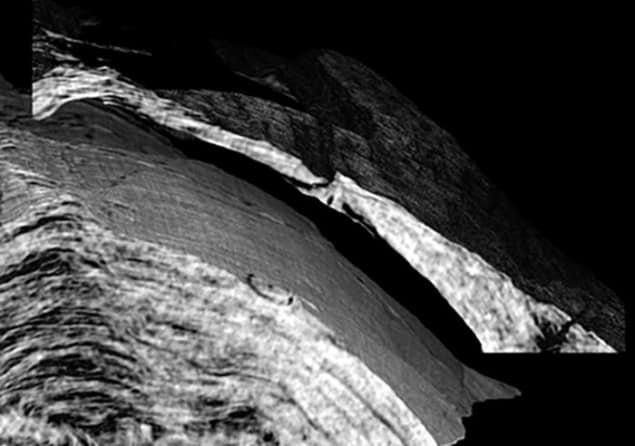
Ancient rolls of manuscript that were carbonized during the eruption of Mount Vesuvius in 79 AD have been virtually unfolded by scientists in Italy. Having probed the “Herculaneum papyri” with X-rays, the researchers were able to isolate individual layers from the extremely delicate and heavily distorted rolls and identify Greek letters written on them. They are currently refining their technique and hope shortly to be able to read significant portions of the ancient text.
The Herculaneum papyri, discovered in the mid-18th century, were stored in the library of a huge villa overlooking the Bay of Naples that some think belonged to the father-in-law of Julius Caesar. Numbering more than 1800 and concerned, at least in part, with the work of the Greek philosopher Epicurus, the scrolls were carbonized and buried by volcanic material from Vesuvius. Although the eruption preserved the manuscripts for posterity, the high temperatures and pressures it generated also crushed and partially melted the precious texts.
Unrolling headache
Trying to unfold and read the very fragile and irregularly shaped scrolls has proved a major headache for scholars. Some of the best-preserved texts have been unrolled by mechanical techniques, but others have been partially or completed ruined. Meanwhile, many non-invasive techniques – such as multispectral imaging and X-ray fluorescence – are unable to penetrate the unrolled manuscripts and therefore cannot distinguish features on internal layers.
The latest work exploits a technique known as X-ray phase-contrast tomography (XPCT). Conventional X-ray tomography records the extent to which different materials absorb the radiation. But it is of little use when trying to distinguish different materials with very similar densities – such as the black carbon-based ink used to write on the papyri and the carbonized papyri themselves. XPCT instead relies on the X-rays’ phase changing as the photons takes different paths through a sample. The technique is sensitive enough to detect the variation in refractive index between a minute blob of ink and the papyrus surrounding it.
The Herculaneum papyri were first analysed using XPCT by Vito Mocella of the Institute of Microelectronics and Microsystems in Naples and colleagues. In 2013, they exposed two papyri from a collection in Paris to X-rays from the European Synchrotron Radiation Facility (ESRF) in France. As they reported two years later in Nature Communications, Mocella and team found they could identify segments of writing within the manuscripts. However, at that stage they did not attempt to virtually unroll the papyri.
Virtual handling
In the new research, presented on arXiv, physicists Alessia Cedola and Inna Bukreeva of the National Research Council Institute of Nanotechnology in Rome also used the XPCT technique at ESRF in 2016. Looking at two papyri from the National Library of Naples, they were able to combine their data-taking with a new way of virtually unrolling the scrolls. Rather than tracing out the geometry of individual papyri layers by observing the objects’ cross-sections, they instead used a 3D technique, which, says Cedola, allows them to study a larger portion of the text.
The researchers start by carrying out the digital analogue of traditional mechanical separation – they virtually remove a portion of a papyrus within a 3D tomographic reconstruction of the scroll. They then peel away the individual layers one by one, noting signs of any potential handwriting as they do so. If they do come across what appear to be letters, they flatten their virtual layer by adjusting its shape until the criss-crossed fibres that naturally make up the papyrus form a geometric grid.
Doing so, they have been able to identify several regions of potential text, the most extensive of which they reckon contains 14 lines of letters. Although many of the letters are yet to be deciphered, Cedola and co-workers nevertheless conclude that their technique has enabled “the most extensive potential textual portions ever read so far” from still-rolled Herculaneum papyri.
Deciphering challenge
Two “papyrologists”, also from the National Research Council in Rome, are working alongside Cedola and Bukreeva to decipher the text, having confirmed that it was probably written by philosopher and poet Philodemus, a follower of Epicurus. They hope to have completed their task by around the end the year. Then in early 2018, Cedola’s team plans to go back to Grenoble and investigate a number of papyri using a higher-resolution X-ray detector. Doing so, she explains, will allow them to better flatten the virtual layers and as such more easily remove unwanted shadows caused by undulations in the papyri. “We will be able to say with greater confidence what is a letter and what is shadow,” she says.
Mocella says that the latest research is “interesting work”, but maintains that it “doesn’t represent a significant advance” on his own group’s efforts. He adds that since publishing their initial results in 2015, he and his colleagues have been able to “virtually unroll some particularly large portions of papyrus on which we are currently improving the readability”.



